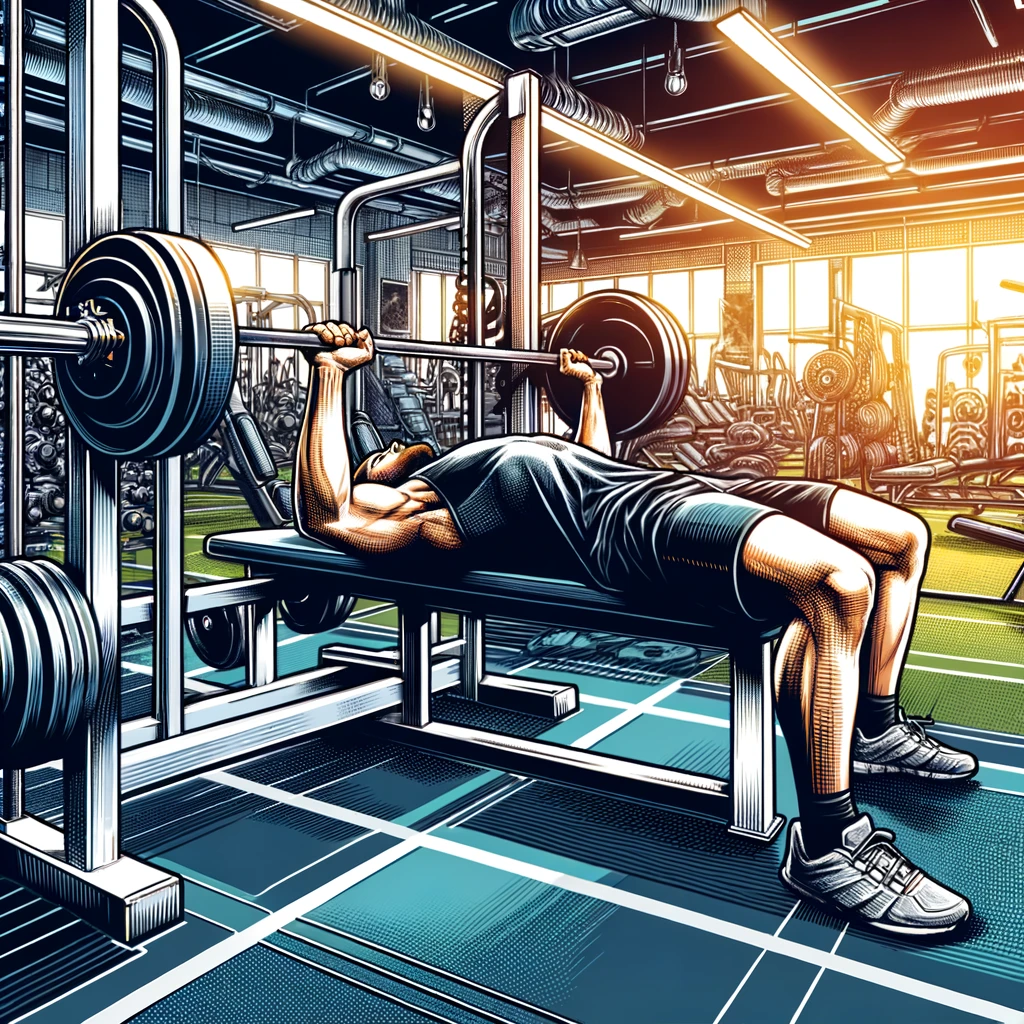The chest is one of the most prominent muscle groups in the body, and many people strive to achieve a well-defined and muscular chest. To unlock your chest potential and develop a strong, sculpted chest, it is important to incorporate a variety of exercises into your workout routine.
Stay with us as we explore essential exercises that will help you elevate your chest workout and achieve your desired results.
The Timeless Flat Barbell Bench Press
One exercise that has stood the test of time when it comes to chest development is the flat barbell bench press. This compound movement targets the entire chest, as well as the triceps and shoulders.
Mastering Proper Form for the Flat Barbell Bench Press

To maximize the benefits of the flat barbell bench press, it is crucial to master proper form. Start by lying flat on a bench with your feet firmly planted on the ground. Grip the barbell with a slightly wider than shoulder-width grip, and lower it slowly towards your chest while keeping your elbows tucked in. Press the barbell back up to the starting position, focusing on squeezing your chest muscles at the top of the movement. Remember to breathe evenly throughout the exercise and avoid arching your back.
Now, let’s delve deeper into the intricacies of the flat barbell bench press. This classic exercise has been a staple in strength training and bodybuilding routines for decades, and for good reason. Not only does it target the chest muscles, but it also engages the triceps and shoulders, making it a highly effective compound movement.
When performing the flat barbell bench press, it’s important to pay attention to your body positioning. Start by lying flat on a bench, ensuring that your feet are firmly planted on the ground. This provides a stable base of support and allows you to generate maximum power during the exercise.
Next, focus on your grip. Grab the barbell with a slightly wider than shoulder-width grip, which allows for optimal chest activation. This grip width also helps to distribute the load evenly across your chest, reducing the risk of muscle imbalances or strain.
As you begin the descent, keep your elbows tucked in close to your body. This not only helps to maintain proper form but also places more emphasis on the chest muscles. Lower the barbell slowly and under control, aiming to bring it down to your chest just below the nipple line.
Once you’ve reached the bottom position, it’s time to press the barbell back up. Focus on driving through your chest muscles and triceps, pushing the weight back to the starting position. As you reach the top of the movement, squeeze your chest muscles to fully engage them and enhance the effectiveness of the exercise.
Throughout the entire flat barbell bench press, remember to breathe evenly. Inhale as you lower the barbell and exhale as you press it back up. This rhythmic breathing pattern helps to stabilize your core and maintain proper form.
Read Also: Building Optimal Physique: Essential Anabolics for Muscle Growth
Additionally, be mindful of your back position. Avoid arching your back excessively, as this can put unnecessary strain on your spine. Instead, maintain a slight natural arch in your lower back, which promotes stability and prevents injury.
By mastering proper form and technique, you can make the most out of your flat barbell bench press. As with any exercise, it’s important to start with lighter weights and gradually increase the load as you become more comfortable and confident in your abilities.
Remember, consistency is key. Incorporate the flat barbell bench press into your regular workout routine and watch as your chest muscles develop and strengthen over time. Whether you’re a seasoned lifter or just starting out, this timeless exercise is sure to deliver impressive results.
Elevate Your Chest Workout with the Incline Dumbbell Bench Press

Incorporating the incline dumbbell bench press into your routine can help you target the upper chest muscles, providing a well-rounded chest development.
The upper chest muscles, also known as the clavicular fibres of the pectoralis major, are often neglected in chest workouts. However, by adding the incline dumbbell bench press to your routine, you can specifically target and strengthen these muscles.
The incline dumbbell bench press is a compound exercise that engages multiple muscle groups, including the chest, shoulders, and triceps. By performing this exercise on an adjustable bench set at a 45-degree angle, you create a higher degree of incline, placing more emphasis on the upper chest muscles.
Targeting Upper Chest Muscles with the Incline Dumbbell Bench Press
To perform the incline dumbbell bench press, position an adjustable bench at a 45-degree angle. This angle allows for optimal activation of the upper chest muscles.
Begin by holding a pair of dumbbells with your palms facing forward and arms extended. Ensure that the dumbbells are at shoulder width apart, providing stability and balance throughout the exercise.
Lower the dumbbells slowly towards your upper chest, focusing on maintaining control and stability. Keep your elbows at a 45-degree angle to maximize the activation of the upper chest muscles.
As you reach the bottom of the movement, pause for a brief moment, feeling the stretch in your chest muscles. This pause allows for a greater range of motion and increased muscle activation.
Push the dumbbells back up, focusing on contracting your chest muscles at the top of the movement. Squeeze your chest muscles together, creating tension and maximizing the effectiveness of the exercise.
Throughout the entire exercise, it is important to maintain proper form and technique. Avoid using excessive momentum or swinging the weights, as this can lead to injury and diminish the effectiveness of the exercise.
Incorporating the incline dumbbell bench press into your chest workout routine can help you achieve a well-rounded chest development. By specifically targeting the upper chest muscles, you can create a balanced and aesthetically pleasing chest appearance.
Remember to start with a weight that allows you to perform the exercise with proper form and technique. As you become more comfortable and stronger, gradually increase the weight to continue challenging your muscles.
Additionally, it is important to listen to your body and adjust the incline angle and weight accordingly. Everyone’s body is different, and what works for one person may not work for another. Experiment with different angles and weights to find the optimal incline dumbbell bench press variation for your individual needs.
So, elevate your chest workout and take your upper chest muscles to new heights with the incline dumbbell bench press. Incorporate this exercise into your routine and watch as your chest development reaches new levels.
Sculpting Your Chest with the Dumbbell Chest Fly
The dumbbell chest fly is an effective exercise for isolating the chest muscles and developing definition. It targets the pectoralis major, the large fan-shaped muscle that covers the front of the chest. By performing the dumbbell chest fly regularly, you can enhance the size and strength of your chest, giving it a more sculpted and defined appearance.
While the dumbbell chest fly primarily targets the chest muscles, it also engages the shoulders and triceps to a lesser extent. This compound movement not only helps you build a well-rounded chest, but it also improves upper body stability and coordination.
Perfecting Your Technique for the Dumbbell Chest Fly
To perform the dumbbell chest fly, lie flat on a bench with a dumbbell in each hand. Make sure the bench is sturdy and secure to avoid any accidents or injuries. Begin by extending your arms above your chest, with your palms facing each other. This starting position allows for a greater range of motion and increased stretch in the chest muscles.
As you lower the dumbbells out to the sides in a wide arc, focus on maintaining control and feeling a deep stretch in your chest. It’s important to keep your elbows slightly bent throughout the exercise to prevent excessive strain on the shoulder joints. This slight bend also ensures that the tension remains on the chest muscles, rather than shifting to the triceps.
Once you reach the bottom of the movement, pause for a brief moment to maximize the stretch in your chest. This pause allows the muscles to fully activate and engage, leading to greater muscle growth and development. From the bottom position, bring the dumbbells back up to the starting position by squeezing your chest muscles and using their strength to push the weights up.
Throughout the entire exercise, it’s crucial to maintain proper form and technique. Avoid using momentum or swinging your arms to lift the dumbbells, as this can diminish the effectiveness of the exercise and increase the risk of injury. Instead, focus on a slow and controlled movement, emphasizing the contraction of your chest muscles at the top of the movement.
Remember to breathe steadily throughout the exercise, inhaling as you lower the dumbbells and exhaling as you push them back up. This rhythmic breathing pattern helps you maintain focus, control, and stability during the exercise. Here is a resource on breathing techniques during workouts.
As with any exercise, it’s important to start with a weight that challenges you but allows you to maintain proper form. Gradually increase the weight as you become stronger and more comfortable with the movement. Additionally, always warm up before performing the dumbbell chest fly to prepare your muscles and joints for the workout.
Incorporating the dumbbell chest fly into your regular chest workout routine can lead to significant improvements in chest strength, size, and definition. Remember to listen to your body and adjust the weight and intensity as needed. With consistent effort and proper technique, you’ll be well on your way to sculpting a strong and impressive chest.
Strengthening Your Chest with the Cable Crossover
The cable crossover exercise is a great way to add variety to your chest workout and target the inner chest muscles.
Maximizing Muscle Activation with the Cable Crossover
To perform the cable crossover, stand in the middle of a cable machine with the cables set at a height slightly above your shoulders. Grasp the handles and step forward, keeping your arms slightly bent. Bring your arms down and across your body in a sweeping motion, focusing on squeezing your chest muscles at the center of the movement. Slowly reverse the motion back to the starting position, maintaining control throughout the exercise.
Achieving a Chiseled Chest with an Effective Workout Routine
Now that you are familiar with these essential chest exercises, it is time to incorporate them into an effective workout routine to achieve a chiselled chest.
Designing a Chest Workout for Lean Muscle Growth

Here is an example of a chest workout routine that you can incorporate into your weekly training:
- Flat Barbell Bench Press: 4 sets of 8-10 reps
- Incline Dumbbell Bench Press: 3 sets of 10-12 reps
- Dumbbell Chest Fly: 3 sets of 12-15 reps
- Cable Crossover: 3 sets of 10-12 reps
Remember to warm up properly before starting your chest workout and listen to your body to avoid injury. As you progress, gradually increase the weight and intensity of your exercises to continue challenging your chest muscles and promoting muscle growth.
In conclusion, unlocking your chest potential requires a strategic combination of exercises that target different areas of the chest. By incorporating the flat barbell bench press, incline dumbbell bench press, dumbbell chest fly, and cable crossover into your routine, you can develop a well-defined and muscular chest. Remember to focus on proper form, vary your exercises, and continuously challenge yourself to achieve the best results.

